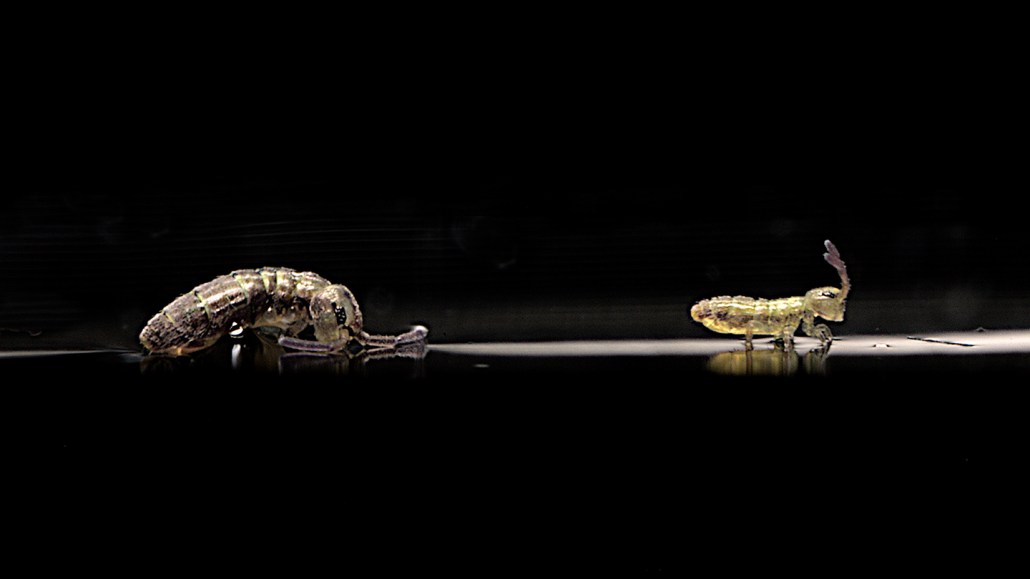Video reveals that springtails are tiny acrobats
The animals' emergency jumps are more controlled than scientists realized

One tiny springtail (left) prepares to launch itself high off of a water surface with far more acrobatic control than researchers have recognized. The other springtail shows how easily these little animals stroll on water.
V.M. Ortega-Jiménez
It’s not just panic and chance. Some of nature’s extreme self-launchers, the springtails, turn out to be much more acrobatic than scientists thought.
Springtails, poppy seed–sized cousins of insects, “are famous because they know how to jump but also famous because they have no control at all according to the literature,” says biomechanist Victor M. Ortega-Jiménez of the University of Maine in Orono.
But in a study published November 7 in Proceedings of the National Academy of Sciences, he and colleagues have used high-speed video to challenge that received no-control “wisdom.”
Springtails tend to be ignored by most people because they are so hard to see with the naked eye. What’s more, the 3,000 plus known species do virtually no harm to people and thus don’t even get the attention we pay to ticks and fleas. Some springtails look like lemon drop candies with big spots of eyes and six legs; other species grow more stretched out (SN: 4/24/20).
The unusual organs used for jumping are one of the reasons springtails are no longer considered insects. Springtails (in the taxonomic group Collembola) evolved as insectlike animals with no wings but a long, hinged ground-smacker, called a furcula, latched underneath the springtail body.
Releasing it to whack downward against the ground, or even against water, launches a springtail high into the air and away from danger such as a hungry fish. Some springtail species have ground-smacked themselves to safety at speeds of 280 times their own body length per second. That’s the jump that biologists used to think would send a little body flipping upward with no control at all.
Questioning that notion starts with pandemic musing, Ortega-Jiménez remembers. He was at Georgia Tech in Atlanta, but with labs closed and “a lot of time with my family on rivers in Georgia,” he says. That’s how he saw springtails launching themselves out of the water but usually landing on land — and the jumps just didn’t look random to him.
Once labs reopened, he and a wide collaboration of colleagues attacked the problem of exactly what happens during springtails’ emergency launches. Focusing on the semiaquatic species Isotomurus retardatus, films at such extreme speeds as 10,000 frames per second showed plenty of control.
Springtails are not in fact just squiggles hurtling helplessly through the air. They curl their bodies while in flight in such a way that they stop tumbling and fall oriented for landing, both video and mathematical models showed. This orienting while falling is something cats and some other animals do well, but Ortega-Jiménez notes that springtails do it faster than any other animal tested, at less than about 20 milliseconds.
That landing uses another distinctive springtail body part, a short wide tubelike organ called a collophore that sticks down out of the abdomen. The animal in profile looks like some plastic toy just out of a mold with the collophore hanging from its tummy like a tab not snapped off yet.
A bit of water in the tubular collophore gives it some weight that helps keep the jumper from bouncing into somersaults as it splashes down on the water surface.
Springtails in lab pools landed on their feet about 85 percent of the time, the team found. Mimicking the landings with a springtail-inspired robot not much bigger than a penny achieved 75 percent landing success.
All this attention to springtail jumping prowess cheers Anton Potapov, a soil animal ecologist at the University of Göttingen in Germany, who was not involved in the study. Springtails “are not only cute and interesting to look at; they are also among the most numerous and functionally important animals on our planet,” he says.
“You can find them virtually everywhere, and they contribute to so many ecosystem processes,” such as plant and microbial growth. Long — and high — may they jump.






